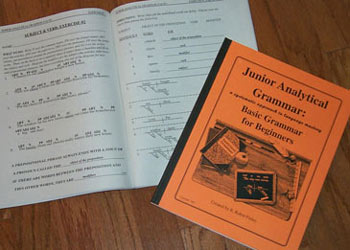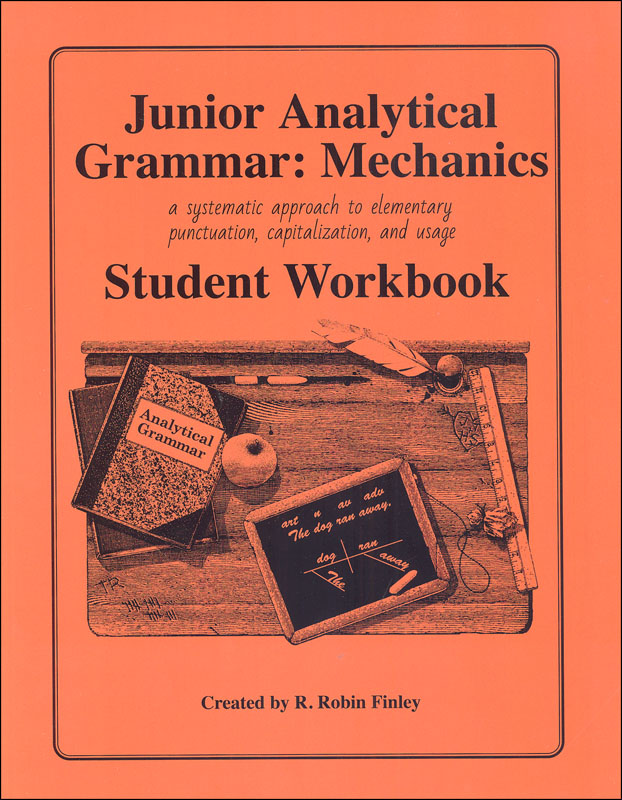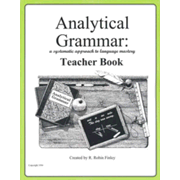Robin Finley drew upon her years of teaching experience to come up with very practical course material for covering English grammar. Junior Analytical Grammar (JAG) and Junior Analytical Grammar: Mechanics (JAGM) are appropriate for fourth or fifth graders, while Analytical Grammar (AG) should be used for students in grades six and up. Optional teaching DVDs are available for JAG, JAGM, and AG; these feature Robin Finley or Erin Karl providing instruction for each lesson and demonstrating a few practice sentences. The DVDs can lighten the load for parents.
JAG might be completed in as few as eleven weeks. It focuses on parts of speech and syntax (word functions within a sentence), and it introduces sentence diagramming early in the process. While it also has writing assignments at the end of each lesson, it does not cover punctuation, usage issues such as verb tenses and comparative forms of adjectives, dictionary skills, comprehensive composition skills, and other language art skills. JAGM can be used to cover punctuation, capitalization, and usage when students have completed JAG. With 15 week-long units, JAGM can be used in the same year as JAG.
AG is more comprehensive than JAG. It reviews and expands upon JAG in the first ten units. These ten units should be used during a single school year (likely about sixth grade). You can continue that same year with the next section (units 11 through 17) which covers sentence structure, clauses (adjective, adverb, and verbal), and appositives. Or you might save this section for the next school year.
Units 18 through 28 of AG teach punctuation. Of course, students will have learned some basic punctuation before this point, but Finley saves intensive punctuation instruction until this point because she says, “students must understand the grammar of the English language before they can be expected to internalize rules of punctuation.” The final lessons in units 29 through 35 deal with specialized usage issues such as pronoun-antecedent agreement, who/whom, and errors regarding adverbs and adjectives. Although the book is divided into its three “seasons” to spread out over two or three years, an older student (grade nine or higher) can easily get through the entire program in less than a full school year.
Lessons follow a common format in both JAG and AG by beginning with an introductory page (or more) of “notes” that teach the lesson. The parent/teacher should go through this material with the student, especially in JAG. Three exercises follow. Students should complete only one of these per day, going over each completed exercise with you before going on to the next one. A writing assignment follows the exercises. Each unit ends with a test.
Complete grading information is provided for the teacher. Finley thought out all of the difficulties in grading both sentence diagrams and writing assignments, so she presents easy ways for parents to score student work.
These courses have a combination of special features that, in combination, set JAG and AG apart from others:
- Students learn parts of speech and syntax at the same time.
- Diagramming is a key component.
- A sentence parsing process is used that is similar to a flow chart approach with questions and answers.
- Grammar is taught thoroughly so students need not repeat the same material year after year.
- Grammar is taught in context so students are more likely to understand and remember it.
- “Notes” pages remain in student books while exercise pages are removed. The student ends up with a reference notebook at the end of the course.
Since Finley suggests taking a break from AG after the first ten units, she has created a Reinforcement & Review (RR) book with exercises for students to continue sharpening their grammar and writing skills. As with AG, RR is divided into sections. The first 18 worksheets use excerpts from well-known literary works and are intended for students to use during the break from doing AG by completing one every other week. Students parse sentences, write paraphrases, then parse AND diagram sentences using all of the concepts taught in units 1 through 10. Answer keys for these worksheets are in this same book. The next section in RR is intended as a week-long review after the break between units 10 and 11 for those who need to do a little more intensive work before continuing on into the next section of AG. Students review their notes pages from AG then complete these worksheets in RR. At the end, ten more reinforcement lessons like those at the beginning of RR are to be used during the next scheduled break between units 17 and 18. These are higher-level reinforcements that cover everything from units 1 through 17. While RR is not essential, I think breaking up the AG course with the RR worksheets will be more interesting for students in addition to giving them more practice.
A few additional notes on AG: while this book has composition activities, it isn’t intended for composition instruction such as how to structure a paragraph or an essay. Also note that although the AG course is expensive, you will be using it over at least two years. While AG isn’t a specifically Christian curriculum, one of the literary selections is Psalm 23, and I spotted one sample sentence that mentioned Jesus and His disciples.
High School Grammar Reinforcements
If high school students have completed AG or another rigorous grammar program, parents and teachers generally want them to have some sort of review or practice on skills.
Robin Finley and Erin Karl have teamed up to create four High School Reinforcement books for this purpose. Each book has activities that reinforce sentence parsing and diagramming, grammar analysis, punctuation, and usage. With 18 lessons per book, you would use approximately one lesson every two weeks for a school year. Each book also contains its own answer key. You might select a book to coordinate with literature studies. The titles are The Great American Authors, The Great British Authors, Shakespeare’s Plays, and The Great World Authors. The sentences and passages with which students work all include information about authors and their works that is readable for its own sake––something we rarely find in grammar resources
Summary
Overall, the Analytical Grammar courses do a thorough job with grammar and diagramming and are easy for both teacher and student to use. However, you might need to work through sentence analysis and diagramming together with some students more than others. In the end, I think most students will appreciate the efficiency of this approach, even if it is challenging














